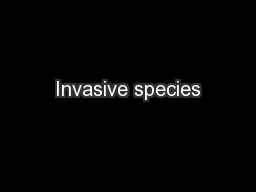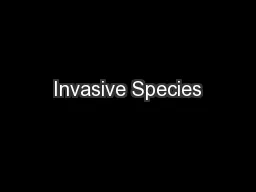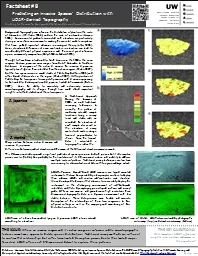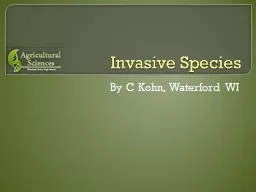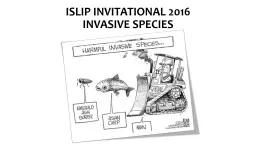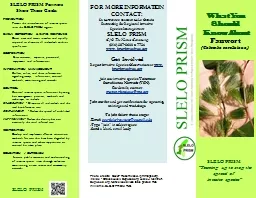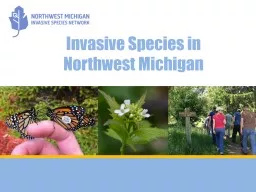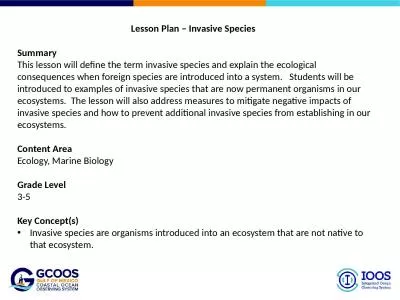PPT-Invasive Species By
Author : liane-varnes | Published Date : 2019-11-07
Invasive Species By Megajude and Phil The Thrill American Bullfrog The American Bullfrog is an invasive species because it can eat just about anything This can impact
Presentation Embed Code
Download Presentation
Download Presentation The PPT/PDF document "Invasive Species By" is the property of its rightful owner. Permission is granted to download and print the materials on this website for personal, non-commercial use only, and to display it on your personal computer provided you do not modify the materials and that you retain all copyright notices contained in the materials. By downloading content from our website, you accept the terms of this agreement.
Invasive Species By: Transcript
Invasive Species By Megajude and Phil The Thrill American Bullfrog The American Bullfrog is an invasive species because it can eat just about anything This can impact the environment in a very negative way because lots of species can go extinct It has predators but it produces a toxin that will prevent them from eating it They originated from central Florida and they have been spotted in New York A method of eradication is electro shocking. Browne M Boudjelas S De Poorter M 2000 100 of the Worlds Worst Invasive Alien Species A selection from the Global Invasive Species Database Published by The Invasive Species Specialist Group ISSG a specialist group of the Species Survival Commission „But the cardoon (Cynara cardunculus) has a far wider range.: it now occurs in these latitudes on both sides of the Cordillera across the continent. I saw it in unfrequented spots in Chile, Entre Rios, and Banda oriental. In the latter country alone, very many (probably several hundred) square miles are covered with one mass of these prickly plants, and are impenetrable by man or beast. Over the undulating plains, where these great beds occur, nothing else can live. Before their introduction, however, I apprehend the surface supported as in other parts a rank herbage. I doubt whether any case is on record of an invasion of so grand scale of one plant over the aborigines”. By: Elizabeth S. Butler. Pd. 3. What is an Endangered Species?. An Endangered Species is a species of animal that is on the brink of extinction. The . endangered . animal is usually close to extinction because of . The Dirty Dozen. Plus Friends. Paul Dolan. Small Forest are A Big Deal. Invasive Plants. Japanese . Stiltgrass. Microstegium. . vimineum. Invasive Plants. What is an Invasive? . Invasive species:. LiDAR-derived Topography. Citation: . Hannam, M.,L.M. Moskal and S. Wyllie-Echeverria, 2009. Predicting an Invasive Species’ Distribution with LiDAR-derived Topography. Factsheet # 8. Remote Sensing and Geospatial Application Laboratory, University of Washington, Seattle, WA. Digital version of the fact sheet can be downloaded at: . Eco Route. Environmental Consultancy. INTRODUCTION. Th. e. . following . presentation . is aimed at dealing. with the control of alien invasive vegetation on private property in particular. The purpose, therefore, is to assist landowners to better understand the procedures that are required for the control of alien invasive vegetation in line with the National Environmental Management Biodiversity Act, 2004 (Act 10 of 2004) (NEMBA) and the Invasive Alien Species (IAS) Regulations and . Can you name an invasive species in our area?. What is an invasive species?. An . invasive . species is an organism that…. Is not . native to an . ecosystem (it may be native to the region). Is . likely to . Imagine, for a moment…. Imagine, for a moment, that every hardwood deciduous tree in the community has died.. There are no trees lining the streets. The environmental center has had to be completely clear cut. STATION #1. INVASIVE SPECIES #1. INVASIVE SPECIES #2. STATION. #1. Provide the common name for . INVASIVE SPECIES #1. [1]. Provide the common name for . INVASIVE SPECIES #2. [1]. Identify the sex of the adult shown in the image for . KAREN LANCOUR. National Rules Committee Chairman- Life Sciences. Event Rules – . 2017. . DISCLAIMER. . This presentation was prepared using draft rules. There may be some changes in the final copy of the rules.. SLELO PRISM “Teaming up to stop the spread of invasive species” FOR MORE INFORMATION CONTACT: St. Lawrence Eastern Lake Ontario Partnership for Regional Invasive Species Management Invasions in the Water: DNA Barcodes of Invasive Species from Lower Yaphank Lake and Others Alex Corozza 1 , Alfredo Delcastillo 1 , Preeti Ramesh Kumar 1 Connetquot Highschool 1 Habitat Matters. Nature’s Vast, Unseen World. Double-toothed prominent (. Nerice. . bidentata. ) on an elm leaf. . Carol Groves. Pandorus. sphinx moth . (. Eumorpha. . pandorus. ) on a Virginia creeper at Kids Creek Park. . Summary. This lesson will define the term invasive species and explain the ecological consequences when foreign species are introduced into a system. Students will be introduced to . e. xamples of invasive species that are now permanent organisms in our ecosystems. The lesson will also address measures to mitigate negative impacts of invasive species and how to prevent additional invasive species from establishing in our ecosystems. .
Download Document
Here is the link to download the presentation.
"Invasive Species By"The content belongs to its owner. You may download and print it for personal use, without modification, and keep all copyright notices. By downloading, you agree to these terms.
Related Documents


